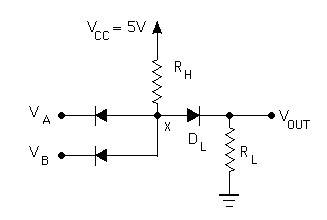Low to High
Transistion
- The time required to discharge the Q1 depletion layers is
<< 1ns.
- The time required to extract the Q2 base charge is also
<< 1ns:
- Q1 becomes forward active;
- IBR becomes large for Q2
- Removal of base charge from QO is similar to the DTL
case. With R2 = 1 kW,
ts = 10ns (typical values for 7400 series TTL).
|
High to Low
Transistion
- The depletion capacitance of the Q1 EB junction must
discharge;
- Base charge must be removed from the saturated Q2
- Ditto for QO
- The capactive load must be charged to VCC.
|









